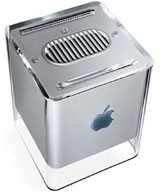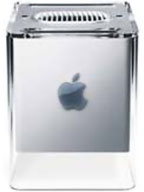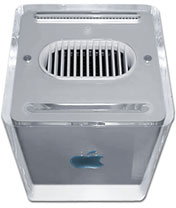Sunday, July 3, was the 10th anniversary of Apple's announcing that
it had decided "to suspend production of the Power Mac G4 Cube
indefinitely." The company said there was a small chance it would
introduce an upgraded model of the unique computer in the future, Steve
Jobs apparently reluctant to pull the plug definitively on his "silent
supercomputer" that packed "the performance of a Power Mac G4 in a 7.7"
wide, 7.7" deep, and 9.8" tall, 14 pound enclosure."
 It had been in production
less than a year.
It had been in production
less than a year.
Being a Cube owner at the time, I could appreciate his reluctance.
The Cube was a very cool (albeit flawed) machine, the sheer audacity of
which Apple has never quite matched with any subsequent Apple product.
No official Cube discontinuation notice has ever been issued, but with
the passage of a decade, it's safe to say that "suspension" of
production is now permanent.
The Cube was a pleasure just to sit and look
at.
I had purchased my Cube, an open-box 450 MHz unit with a respectable
(in those days) 20 GB hard drive and 576 MB of RAM from Low End Mac's
Dan Knight, who had used it lightly, for about $1,300 in May 2001.
Unboxing the Cube, it struck me that it was most visually striking
computer I'd ever seen - a feast for the eyes. Why these machines
didn't sell better on aesthetics alone is a mystery to me. The Cube was
a pleasure just to sit and look at.
Marketing Problems
But there were definitely marketing problems. Apple never publicly
explained its marketing target strategy for the Cube, but a broad
consensus held that it was aimed at upscale professional types as a
sort of functional objects d'art for their tony offices.
 If so, that was not a winner
of a plan. The Cube's crystal polycarbonate-encased CPU module was
strikingly attractive and compact in dimensions, but that had been
achieved only by shifting the power supply to a huge power brick that
was as homely as the Cube was handsome, and audio-out to a couple of
Harman-Kardon satellite speakers with a 4" x 2" x 0.5 " external
amplifier, housed in three more crystal-encased modules that were
attractive enough to look at, but added to the clutter, as did the
necessary external monitor, keyboard, mouse, and attendant spaghetti
tangle of cables to connect everything. The total amount of desktop
real estate required not that different from a typical desktop or tower
computer of the day.
If so, that was not a winner
of a plan. The Cube's crystal polycarbonate-encased CPU module was
strikingly attractive and compact in dimensions, but that had been
achieved only by shifting the power supply to a huge power brick that
was as homely as the Cube was handsome, and audio-out to a couple of
Harman-Kardon satellite speakers with a 4" x 2" x 0.5 " external
amplifier, housed in three more crystal-encased modules that were
attractive enough to look at, but added to the clutter, as did the
necessary external monitor, keyboard, mouse, and attendant spaghetti
tangle of cables to connect everything. The total amount of desktop
real estate required not that different from a typical desktop or tower
computer of the day.
The literally brick-like power supply could be banished to the
floor or elsewhere out of sight, but the rest of the stuff had to
pretty much remain in plain view. Today, with wireless peripherals,
much of the spaghetti could be dispensed with, but ten years ago wires
were obligatory.
Expensive
Apple's pricing didn't help either. At $1,799, the base 450 MHz Cube
cost more than the $1,599 price of the cheapest professional Power Mac G4 (also 450 MHz,
but with three PCI expansion slots and multiple internal drive bays),
and the 500 MHz version of the Cube that was sold only through the
online Apple Store (this in the days before there were brick-and-mortar
Apple Stores) was priced at $2,299. And those prices were without a
monitor. If you added a 15" Apple Studio Display LCD flat screen
monitor (the most thematically appropriate choice) for $999, you were
up to $2,798.
 By the first calendar quarter
of 2001, Cube sales were down 59% from what had been less than
spectacular performance in the fewer than five months of 2000 that it
had been available, to a miserable 12,000 units sold. (compared with
55,000 iMacs and 250,000 G4 Towers in Q1 2001).
By the first calendar quarter
of 2001, Cube sales were down 59% from what had been less than
spectacular performance in the fewer than five months of 2000 that it
had been available, to a miserable 12,000 units sold. (compared with
55,000 iMacs and 250,000 G4 Towers in Q1 2001).
A price reduction was announced at Macworld Tokyo 2001, with the
entry-level 450 MHz DVD Cube cut to $1,299, and the 15" Apple Studio
Display to $799, reducing sticker shock to a more manageable $2,098 for
the combo, still not a rip-roaring bargain, but at least more
reasonably priced. Unfortunately, it was too little too late. The "Cube
is too expensive" image had become conventional wisdom.
Steve Jobs put a brave face on it, declaring that there were no
plans to discontinue the Cube, but the proverbial handwriting was on
the wall.
I always thought the storm of criticism over the Cube's price was
more than a bit overblown. At the the original $1,799 price point for
the 450 MHz unit, the Cube was no bargain, but it wasn't just another
computer either. I think the real problem wasn't so much the price of
the Cube itself, but the price of Apple's LCD monitors. It seemed
ridiculous to get a tiny (by the standards of the day), jewel-like Cube
and then pair it with one of the hulking great Apple Studio Display 17"
CRTs, the latter being the only reasonably priced monitor Apple sold in
those days.
Other reasons the Cube didn't sell included the "expensive toy for
yuppies" perception. Many didn't take it seriously.
Perhaps it was also because the Cube was a bit of a jack of several
trades and master of none. It was reasonably powerful for general
computing chores, but not suited for really high-end work because of
its lack of PCI expansion potential. It was sort of portable, but not
in the same way that a PowerBook is portable.
It was not super-expensive, but not bargain priced like an iMac
either. In short, the Cube had an identity crisis, and even people who
liked it were inclined to admire it and then move along and buy
something with more precise market focus. "Cube owners love their
Cubes, but most customers decided to buy our powerful Power Mac G4
minitowers instead," Phil Schiller, Apple's vice president of Worldwide
Product Marketing, commented at the time.
The Cube's Closese Successor
In practical terms, the closest analog Apple makes to the Cube today
is the Mac mini, which it's
made in various iterations since 2005, and which has has been a lot
more successful than the Cube was - for good reason. It's much more
versatile, genuinely minuscule, and development of wireless peripherals
and data connectivity technology has helped, as has the mainstream
shift to reasonably-priced flat screen monitors, which were just
beginning to gain traction in the desktop world a decade ago - and, as
we've noted, they were still prohibitively expensive during the Cube's
short time on the market.
The Cube concept was seductive, but it left a fair bit to be desired
in practical execution. For me, while I admired my Cube, I soon
determined that it wasn't quite what I needed - not the compact desktop
laptop substitute I'd been hoping for, and of course it didn't have the
option of battery power. I ended up swapping it after about six months
for a year-old but immaculate Pismo PowerBook. A good
decision as it turned out. I still have that Pismo in regular use. I
wonder if the Cube is still in service?

 It had been in production
less than a year.
It had been in production
less than a year. If so, that was not a winner
of a plan. The Cube's crystal polycarbonate-encased CPU module was
strikingly attractive and compact in dimensions, but that had been
achieved only by shifting the power supply to a huge power brick that
was as homely as the Cube was handsome, and audio-out to a couple of
Harman-Kardon satellite speakers with a 4" x 2" x 0.5 " external
amplifier, housed in three more crystal-encased modules that were
attractive enough to look at, but added to the clutter, as did the
necessary external monitor, keyboard, mouse, and attendant spaghetti
tangle of cables to connect everything. The total amount of desktop
real estate required not that different from a typical desktop or tower
computer of the day.
If so, that was not a winner
of a plan. The Cube's crystal polycarbonate-encased CPU module was
strikingly attractive and compact in dimensions, but that had been
achieved only by shifting the power supply to a huge power brick that
was as homely as the Cube was handsome, and audio-out to a couple of
Harman-Kardon satellite speakers with a 4" x 2" x 0.5 " external
amplifier, housed in three more crystal-encased modules that were
attractive enough to look at, but added to the clutter, as did the
necessary external monitor, keyboard, mouse, and attendant spaghetti
tangle of cables to connect everything. The total amount of desktop
real estate required not that different from a typical desktop or tower
computer of the day. By the first calendar quarter
of 2001, Cube sales were down 59% from what had been less than
spectacular performance in the fewer than five months of 2000 that it
had been available, to a miserable 12,000 units sold. (compared with
55,000 iMacs and 250,000 G4 Towers in Q1 2001).
By the first calendar quarter
of 2001, Cube sales were down 59% from what had been less than
spectacular performance in the fewer than five months of 2000 that it
had been available, to a miserable 12,000 units sold. (compared with
55,000 iMacs and 250,000 G4 Towers in Q1 2001).
